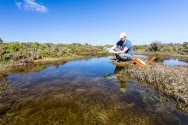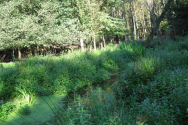Dossier
Streams and stream valleys
Over the past century, streams all over Western Europe have been straightened, enclosed, dammed up and adapted to handle as much and as fast a flow of water as possible. Together with water pollution, this has led to a sharp decline in the ecological quality of streams. Wageningen University & Research carries out research on streams and stream valleys and provides advice on their management and organisation.
Stream valleys are characterised by a stream valley plain enclosed by higher ground, with a stream bed and river banks in between. The banks consist of sediment that is deposited when the stream overflows its banks. Often, besides the active stream bed, other water bodies are present in the valley.
In the previous century, streams were straightened to increase the drainage capacity and thus reduce the risk of flooding. It now appears that streams cut too deeply into the landscape, causing the surrounding landscape to dry up and the water to run off too quickly. As a result, upstream dehydration occurs and typical plants and animals disappear. These developments are counteracted by geomorphological stream restoration.
Geomorphological stream restoration takes into account:
- Restoring the habitat
- Making the stream valley suitable for native organisms
- Retaining and storing water
- Climate change
- Restoring cultural-historical values.
Climate change
Climate change will change the pattern of precipitation, causing periods of drought, but also periods of extreme rainfall. By constructing a buffer zone, the stream valley will be able to store more water. The buffer zone will reduce peak discharges because not all the water will end up in the stream at once, but will be discharged more evenly.
Ecology of the stream valley
The ecology of the area is also very important. For example, insects play a major role in the decomposition of organic material in the water. In order to increase the biodiversity in the stream valley, it is important to restore the watercourses. This creates a diverse landscape that is more attractive to animal and plant species. Introducing dead wood in the stream is a good way to increase the flow variation and heterogeneity of the stream, which also benefits the biodiversity and makes the stream valley more attractive.



